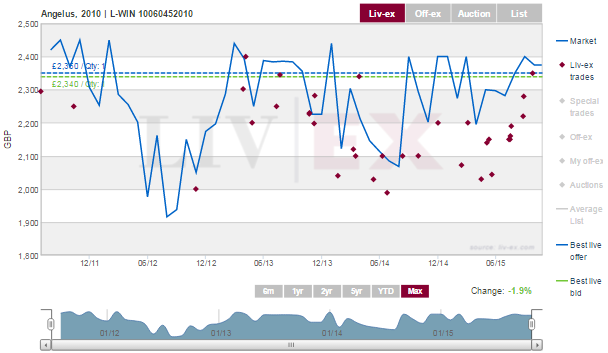Like Montrose 2010, Angelus 2010 has lagged behind the equally scored 2009 vintage. With a current market price of £2,400 per 12×75 it is 7.7% cheaper than the 2009. Both have a score of 99+ from Robert Parker. This price gap puts it amongst the Chateaux with greatest differences between identically scored 2009 and 2010 vintages.
The 2010 has seen some evolution in terms of both price and points. Initially awarded a barrel range of 94-96+ by Parker, it was upgraded to 98 points after the critic tasted the “absolutely spectacular” wine in bottle in February 2013. Shortly after, it saw its highest ever trade price – £2,400 – on the Exchange before subsequently drifting. Prices began to show signs of recovery again towards the beginning of this summer, and a further upgrade to 99+ points in August provided another boost. Its last trade – £2,300 – is just 4.2% below peak. Will it keep on moving?

In a vertical tasting in August 2015, Parker drew comparisons between four acclaimed Angelus vintages:
“How much fun will it be to have the 2000, 2005, 2009 and 2010 in future tastings to see which vintage comes out on top? They are all candidates that will flirt with perfection, depending on the state of their evolution.”
The 2000 and 2005 – shown in the table below – are valued at 38% above the 2009 and 50% higher than the 2010. All of these vintages have comparable scores. As a result, the younger vintages have significantly lower POP* scores – Liv-ex’s loose measure of value, where a lower score suggests better value for money. This makes the 2009 as well as the 2010 look attractive, and along with Parker’s comments suggests room for movement for the two – in terms of both price and points.

*A wine’s POP score is its price-over-points ratio, our loose measure of value. It is calculated by dividing the price of a nine-litre case of wine by a shortened 20-point score (scores from The Wine Advocate). We have calculated this 20-point score by simply subtracting 80 from the official rating (for barrel-score spreads we use the mid-point of the score), on the basis that any wine under 80 points is unlikely to attract a secondary market. In theory, the lower the POP score the better value a wine is.





